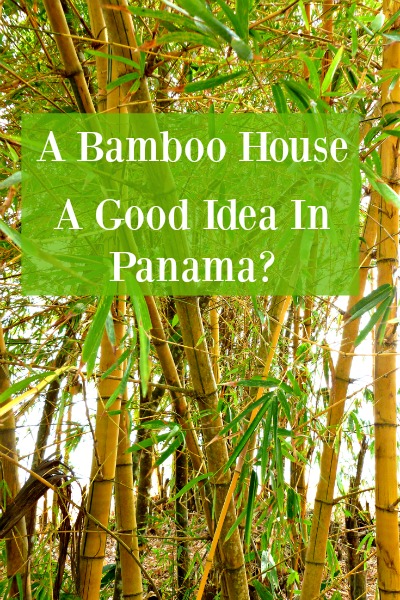
Before moving to Panama, I was already quite familiar with bamboo from my travels in Southeast Asia and while building houses in Japan.
In both Hong Kong and mainland China, I have seen bamboo scaffolding rising up 15, even 20 stories. In Indonesia, I've seen bamboo used for construction of airy pole buildings.
My only real bamboo construction experience has been with Tonkin cane from Vietnam. I still have some Tonkin cane stored along the side of my home in Seattle. It is left over from a fence I built 18 years ago.
Tonkin cane is solid, with literally no hollow core.
The bamboo has been stored outdoors in Seattle’s moist and mild climate for 18 years. It appears to have aged hardly at all. The fence that I built from this bamboo is in nearly the same good condition. Though it has been exposed to sun, rain, high and low temperatures for nearly two decades, I have only replaced a couple of canes in all those years.
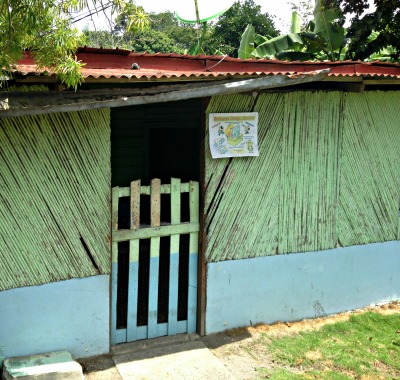
We get plenty of rain and abundant sunshine here in Panama. It is an ideal combination for bamboo habitat. In fact, some of Panama's timber species grow 20 or 30 feet annually and can reach up to 8” in diameter.
In our town of Puerto Armuelles Panama, you can typically get timber bamboo 60 feet tall and 3”-5” in diameter (see photo).
The price is wonderfully affordable. A 60’ length of timber bamboo only costs ~$1.50. Unfortunately, you wouldn't want to use it to build your home.
This is because Panama's timber bamboo has a mostly hollow structure. Which mean it does not last long when used as the exterior of structures.
Most bamboo that I have encountered in Puerto Armuelles, and generally in Panama, appears to be some strain of fast-growing golden bamboo.
Panama's most common bamboos are prone to dry out and crack in the dry season. It also degrades rapidly when exposed to sunlight and is prone to mold and rot.
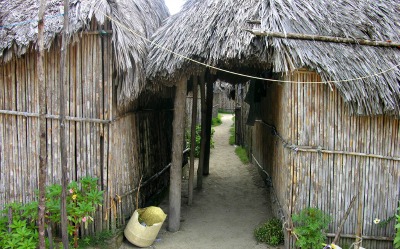
As these 2 photos show, the bamboo typically used to build homes in Panama is what is easily grown and harvested here. A fast-growing golden bamboo.
It is not the type of bamboo that North Americans think of as appropriate for construction. That is because it is not. These are not permanent structures. These homeowners know they will need to replace the bamboo in these small houses every few years.
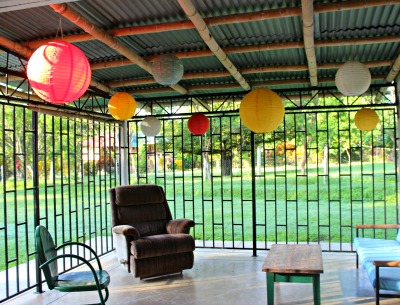
However, sometimes a temporary building structure is just want you need.
We often use timber bamboo as temporary bracing or temporary fencing on our projects. I have made a couple of temporary sheds and a carport with it on our own property or in situations where I am “checking out” a design idea.
Since each 60’ length of timber bamboo costs about $1.50, it is a great, low cost, temporary building material. If it is protected from the sun and rain, the bamboo appears to last several years.
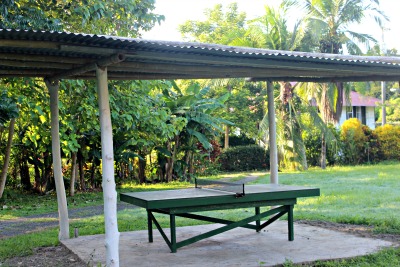
As you can see in the living room photo, we even use it in our own home. The bamboo you see in the photo is about 8 years old. We have replaced the bamboo on top of the zinc roof once in those 8 years. (Note: This open-air living room was added during the remodel, the rest of the house is 2 stories.)
I have seen photos online of beautiful bamboo structures in Costa Rica and other tropical countries.
In fact, I met a German man who has built a Bamboo house just over the border, on the beach in Costa Rica. I have yet to visit his project and find out more about it. I do know that he brought in a builder from a high-end area of Costa Rica who specializes in bamboo construction for expats. It is still on my “to do” list to visit his home and find out what strain of bamboo he used.
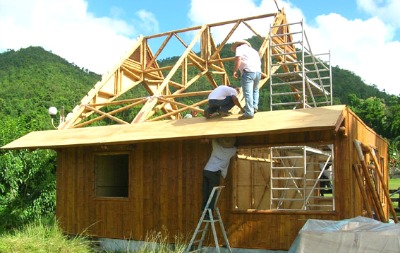
There are roughly 1500 known bamboo species on the planet. However, only a hand-full of them can be used for construction.
In Latin America, including Panama, the yellow striped bamboo, Bambusa vulgaris 'Vittata', is everywhere. Sadly, due to its hollow core, it cannot be used for construction.
The best construction-worthy bamboo grown in Latin America is the Guadua Angustifolia. Unfortunately, it is not a popular crop. Teak is much more popular.
People have been growing teak as an income-crop for many years. Until that changes, there likely won't be a much high-quality Guadua Bamboo available in Panama. Because there isn't much of this bamboo for sale, it will cost you more than you probably want to pay.
However, there seems to be sufficient Guadua Bamboo available in nearby Costa Rica (see Rudy's comment in the comment section).
Until it is more widely available in Panama, that may be a good option. You would have to investigate any import taxes you might have to pay to bring the bamboo over the border into Panama.
Of course, you can import the construction grade bamboo you need from various sources.
At least one of the sources I used to write this post (see below), offers to deliver construction grade bamboo to your building site in Panama. My guess is that cost of importing bamboo, relative to other construction materials, will be expensive. But it does seem worth checking out the cost.
The good thing is if more people want to build with Bamboo, more people will produce it, hopefully in Panama. This increase in supply will decrease the cost of bamboo.
Hopefully, building high-quality bamboo construction in Panama will stop being a luxury construction method.
With a greater supply of construction grade bamboo in Panama, bamboo can become an excellent way to build an attractive and affordable eco-friendly house.
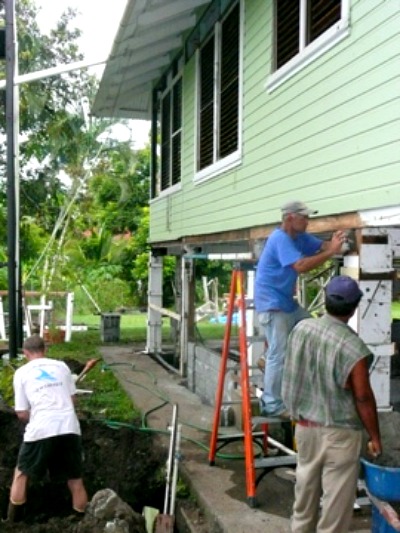
Wood is a great way to build in the highlands of Panama, such as in Boquete and Volcan. Or a place where there is a desire for an insulated wall cavity to contain fiberglass insulation. In the highlands, builders are pretty familiar with wood construction methods, so finding good carpenters is possible.
On the warmer coast of Panama, unless you are air conditioning the whole house, the insulative quality of a 2x4 cavity is not of much benefit.
Having adequate ventilation is far more critical in the warmer lowlands of Panama.
Moisture can collect in unventilated wall insulation. This leads to wood rot and provides a breeding ground for unhealthy mold spores.
As I mentioned, a key reason not to build with wood is termites. Termites are more pervasive in Panama's warmer coastal regions than in the highlands. To be fully protected from termites, any wood used in construction needs to be pressure treated with arsenic, or some equivalent insect repellant. This means that the entire wood structure of your homes would be built of a highly toxic, non-environmental safe material.
If this is not an issue for you, chemically-treated wood is available in nearby David. It is usually imported from Canada. Keep in mind, that it is expensive.
You can use locally available hard woods that are naturally more resistant to pests, but they are just resistant, not impervious. You will have to tend to your wood on regular basis by injecting poison where you see evidence of termite infestations. If you don't do that, your house will slowly be eaten from the inside out.
Wood is definitely not a low-maintenance or low-cost building material choice in Panama. For all these reasons above, we are not using wood as our primary construction material in our Living In Panama House.
Keep in mind, whether you build with wood or not, roof insulation as protection against thermal gain from the sun is needed in both the highland and lowlands of Panama. Solar gain is the main source of the excessive heat in the tropics.
Having said all this, if I were to build a two story structure, I would use both concrete and wood. Concrete for the 1st floor and pressure treated 2x’s for the 2nd floor. The upper floor would be mostly open air with very little wall.
Costs More to Build & Maintain
A house built with both materials is more costly.
Also, finding skilled carpenters in Panama is more of a challenge than finding skilled masons.
Our family likes the ideas of a multiple story house made of wood and concrete. We are toying with building ourselves a 3 story “tree house” on one of our lots by the beach. Of course, we have to assess how much effort we are willing to put into the endeavor.
We are not the only expats who have chosen to remodel a wood house in Panama. There are a few other expats in Puerto Armuelles who have remodeled one of the 2x4 framed Chiquita Banana houses. I believe each of these owners had a lot of construction experience in the US, prior to moving to Panama. So the wooden houses appeared to be familiar terrain to them.
In each case, the owner-builder ended up either doing much of the carpentry himself or had to train his crew from scratch. This is because the labor pool knew nothing about high quality wood construction. Alternatively, they had to accept a grossly inferior product from an incompetent local carpenter. Most of these projects resulted in a combination of the 3 methods above.
One fellow, who is doing a beautiful job remodeling a house in our neighborhood, has been working on his house for over 3 years, and it is still not finished. This fellow is a superb craftsman and the house project is beautiful. However, from my point of view, it is too much money and too much effort. I have spoken with this guy many times over the course of the project. He has said that he would not attempt the project, if he had it to do over.
Our own situation is not dissimilar, although we did not forge ahead quite so doggedly. Our own wooden Chiquita house remodel is only half finished. After six months or so, I finally just fired the crew.
Today, I don’t think too much about my half finished Chiquita Banana House. If I do think about it, I see 2 possibilities for our home. 1) I will complete the project myself, over time, rather than employ locals to do the finicky carpentry. 2), more likely, we will continue to live in the half-remodeled structure.
Our house works fine as it is. In fact, we love to live in it. It feels sort of like living in a huge, well-ventilated artists loft apartment. We have loads of space (about 3500 square feet on two floors).
Not finishing my wood house remodel allows me the time to focus our construction efforts on our beach properties. As a rough comparison, I estimate that I can build 5 or 6 open air, concrete beach houses in the time that it would take to complete the remodel of our wooden Chiquita Banana House. Plus, I think concrete construction is a lot more fun and a more productive use of my time, money, and creative energy.
If you do decide to use wood to build your house, you may want to go the wood and concrete route. Except for the posts, and ceiling structure, the whole bottom floor of our Chiquita Banana house is made of concrete.
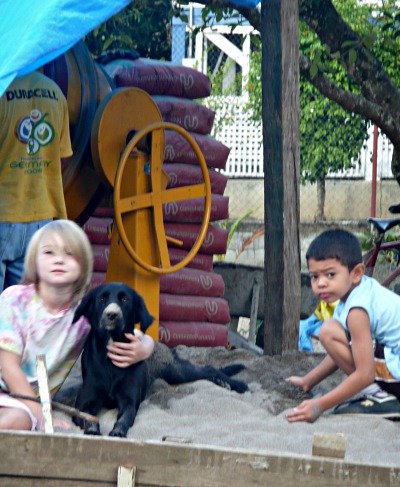
Which is why cement is the typical building material of all of Latin America.
It is also what we use as the primary construction material for our Living in Panama House.
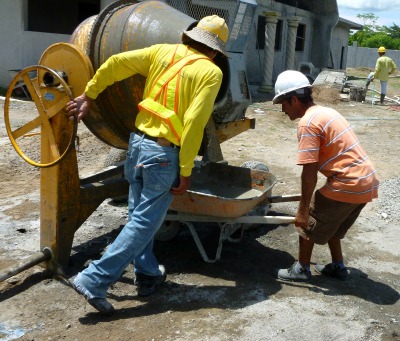
It is wise to keep your construction project within the comfort zone of the local workers. Builders in Panama are most comfortable working with concrete.
Think of Panama as a small town of 100 years ago, where folks are used to doing things the same way, generation after generation. Of course, they can learn new ways, but it won't be a fast, easy, or necessarily successful process.

Concrete block is the most common method of construction. It is usually reinforced with steel rebar and the hollow cells in the blocks are filled with a concrete slurry.
Standard concrete blocks are 16” long and are available in 4” and 6” thicknesses.
Half blocks may be purchased to maintain the overlapping rhythm of the block structure. Block may easily be cut with a grinder, or scored and broken to size. (This is the most common method both in Panama and in North America).
As I mention in another article on hardware stores, the quality of block available in Puerto Armuelles varies greatly from supplier to supplier, and even between batches from the same supplier. You need to inspect each shipment, and even every block. Some blocks literally fall apart in your hands, while others are perfectly adequate, especially if you use plenty of steel reinforcement, and fill all cells with concrete.
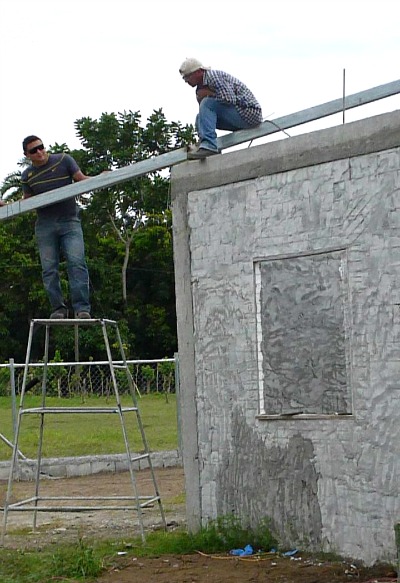
Please note: No block that I have encountered in Panama is of the high quality that one would encounter at a typical home center, or concrete supplier in the States or Canada.
However, I believe that in the very near future, as with everything else in Panama, the quality of local block will rise to the level of that in North America. The growth rate and improvements in quality in Panama are like nothing I have seen anywhere in my lifetime. The pace of growth and modernization in Panama is truly astounding.
Custom Blocks In Puerto
Our best block supplier has agreed to provide custom blocks using a higher ratio of cement to aggregates than his standard block. He will make it your specifications.
In other words, we can start getting that higher North American- quality block in Puerto Armuelles today.
M2 or Convintec is a insulated Styrofoam core panel covered with a galvanized steel mesh that is used
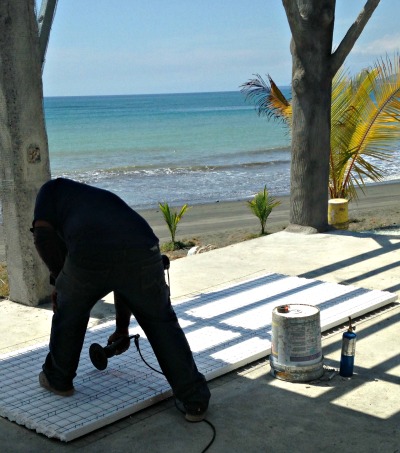
primarily for interior and exterior walls and sometimes for flooring or the roof.
M2 is used in place of concrete blocks, but must be “stucco coated” or "repello" with concrete.
M2 is increasingly popular and allows building to go up very quickly. Some people import higher quality M2 panels than are available in Panama. But most are successful using the locally available M2 panels.
M2 panels come in different thickness. Ideally, you should use panels at least 4 inches thick. Panels thinner than 4 inches have a tendency to buckle and are not load bearing.
Plycem is a fiber cement board widely used to replace wood siding, plywood, tile base in showers, and, at times, sheetrock. It can be cut, sanded, nailed, rough dressed, drilled and screwed with conventional woodworking tools.

There is a similar product to Plycem available in the States. It is called Hardiboard.
Benefits of Plycem
Plycem is designed to be screwed into wood or steel studs and floor joists. 3/4 or 1" Plycem can even replace plywood floors, when placed on closely spaced floor framing using steel studs or wood.
In our own house, we have used Plycem as the base for a tiled kitchen floor as well as for the floor and walls of our bathrooms.
Thanks.
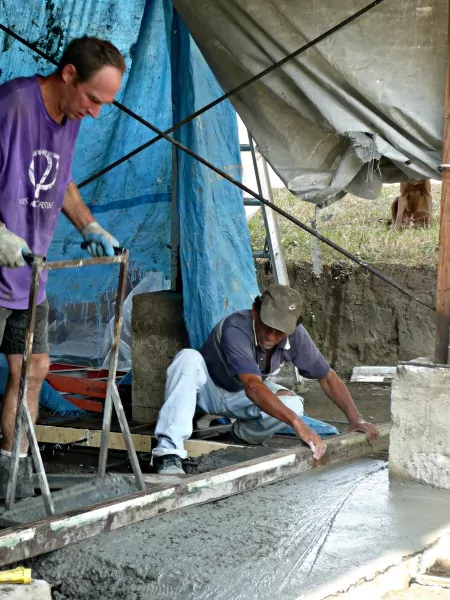
I wrote a post about each of these 4 building materials. The links to those posts are at the bottom of this page.
Whatever construction materials you use for your house, you need think about your choice carefully.
Hopefully, the answer is yes to all of the above questions. If not, make sure you are okay with the extra work and/or cost using your chosen material will entail.
One thing you should be careful about, is using building materials or construction techniques with which the local labor is unfamiliar.
If you get too innovative, you are likely to lose the locals along the way. Certainly, they will not be as interested in trying a new building experiment as you, the northern immigrant. You are in for a shock, if you came to Panama with ego-driven notions of how you would build, once you had moved to paradise, and with labor day rates that are less than half of what hourly rates are up north.
For some of us (I include myself here), this will require that we put our own ego in the “back seat." If you don't, you will face a lot of frustration, cost overruns, and disappointing results.
For me, after a long period of trying get the local builders to do things exactly, precisely my way, I have come to the conclusion that it is just not worth it. Believe me, I have tried it, many times (I am a slow learner). It just does not work. Or if it works, it is not a happy experience for anyone.
There are many wonderful things about the Panamanian people. When taken on their own merits, the people of Panama are kind, peaceful, genuinely warm neighbors, and happy to share their beautiful country with us. However, an intrinsic desire to learn something new, from foreigners no less, is not high on their priority list.
It is my opinion that we expats do best when we accept that fact. When we don’t try to impose our own perfectionism and rigid views upon the locals. Our own culture has certainly made plenty of mistakes, and continues to make mistakes and on a global scale.
Maybe we are being offered this opportunity to compromise a bit, to be less perfectionistic and judgmental . With this attitude well in mind, you can produce an interesting, good quality, project. A project that you can be proud of. And most importantly, you will build your house in a way that will not make enemies of your new Panamanian friends. Those relationships will be a joy for years to come.